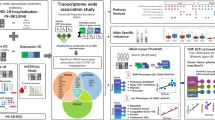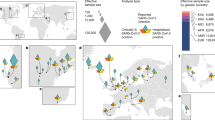Abstract
The stromal-derived factor-1 (SDF-1) chemokine gene encodes the only natural ligand for CXCR4, the coreceptor for the pathogenic X4 HIV-1 strains. A single-nucleotide polymorphism (SNP) in the 3′ untranslated region (SDF1-3′A=rs1801157) of SDF-1 was reported to be protective against infection and progression in some, but not other, epidemiological studies. To identify additional alleles that may influence HIV-1 infection and progression to AIDS, nine SNPs (including rs1801157) spanning 20.2 kb in and around the SDF-1 gene were genotyped in over 3000 African American (AA) and European American (EA) participants enrolled in five longitudinal HIV-1/AIDS natural cohort studies. Six or five haplotypes were present at frequencies greater than 5% in AA or EA, respectively. Six of the nine SNPs occur on only one common haplotype (>5%), while the remaining three SNPs were found on multiple haplotypes, suggesting a complex history of recombination. Among EA, rs754618 was associated with an increased risk of infection (OR=1.50, P=0.03), while rs1801157 (=SDF1-3′A) was associated with protection against infection (OR=0.63, P=0.01). In the MACS cohort, rs1801157 was associated with AIDS-87 (RH=0.31, P=0.02) and with death (RH=0.18, P=0.02). Significant associations to a single disease outcome were found for two SNPs and one haplotype in AA.
This is a preview of subscription content, access via your institution
Access options
Subscribe to this journal
Receive 6 digital issues and online access to articles
$119.00 per year
only $19.83 per issue
Buy this article
- Purchase on Springer Link
- Instant access to full article PDF
Prices may be subject to local taxes which are calculated during checkout

Similar content being viewed by others
References
Ma Q, Jones D, Borghesani PR et al. Impaired B-lymphopoiesis, myelopoiesis, and derailed cerebellar neuron migration in CXCR4- and SDF-1-deficient mice. Proc Natl Acad Sci USA 1998; 95: 9448–9453.
Murdoch C, Monk PN, Finn A . Cxc chemokine receptor expression on human endothelial cells. Cytokine 1999; 11: 704–712.
Tachibana K, Hirota S, Iizasa H et al. The chemokine receptor CXCR4 is essential for vascularization of the gastrointestinal tract. Nature 1998; 393: 591–594.
Pablos JL, Amara A, Bouloc A et al. Stromal-cell derived factor is expressed by dendritic cells and endothelium in human skin. Am J Pathol 1999; 155: 1577–1586.
Ponomaryov T, Peled A, Petit I et al. Induction of the chemokine stromal-derived factor-1 following DNA damage improves human stem cell function. J Clin Invest 2000; 106: 1331–1339.
Tanabe S, Heesen M, Yoshizawa I et al. Functional expression of the CXC-chemokine receptor-4/fusin on mouse microglial cells and astrocytes. J Immunol 1997; 159: 905–911.
Aiuti A, Webb IJ, Bleul C, Springer T, Gutierrez-Ramos JC . The chemokine SDF-1 is a chemoattractant for human CD34+ hematopoietic progenitor cells and provides a new mechanism to explain the mobilization of CD34+ progenitors to peripheral blood. J Exp Med 1997; 185: 111–120.
Mohle R, Bautz F, Rafii S, Moore MA, Brugger W, Kanz L . The chemokine receptor CXCR-4 is expressed on CD34+ hematopoietic progenitors and leukemic cells and mediates transendothelial migration induced by stromal cell-derived factor-1. Blood 1998; 91: 4523–4530.
Poznansky MC, Olszak IT, Evans RH et al. Thymocyte emigration is mediated by active movement away from stroma-derived factors. J Clin Invest 2002; 109: 1101–1110.
Grabovsky V, Feigelson S, Chen C et al. Subsecond induction of alpha4 integrin clustering by immobilized chemokines stimulates leukocyte tethering and rolling on endothelial vascular cell adhesion molecule 1 under flow conditions. J Exp Med 2000; 192: 495–506.
Lavi E, Kolson DL, Ulrich AM, Fu L, Gonzalez-Scarano F . Chemokine receptors in the human brain and their relationship to HIV infection. J Neurovirol 1998; 4: 301–311.
Tran PB, Miller RJ . Chemokine receptors: signposts to brain development and disease. Nat Rev Neurosci 2003; 4: 444–455.
Amara A, Gall SL, Schwartz O et al. HIV coreceptor downregulation as antiviral principle: SDF-1alpha-dependent internalization of the chemokine receptor CXCR4 contributes to inhibition of HIV replication. J Exp Med 1997; 186: 139–146.
Bleul CC, Farzan M, Choe H et al. The lymphocyte chemoattractant SDF-1 is a ligand for LESTR/fusin and blocks HIV-1 entry. Nature 1996; 382: 829–833.
Feng Y, Broder CC, Kennedy PE, Berger EA . HIV-1 entry cofactor: functional cDNA cloning of a seven-transmembrane, G protein-coupled receptor. Science 1996; 272: 872–877.
Oberlin E, Amara A, Bachelerie F et al. The CXC chemokine SDF-1 is the ligand for LESTR/fusin and prevents infection by T-cell-line-adapted HIV-1. Nature 1996; 382: 833–835.
Winkler C, Modi W, Smith MW et al. Genetic restriction of AIDS pathogenesis by an SDF-1 chemokine gene variant. Science 1998; 279: 389–393.
Mummidi S, Ahuja SS, Gonzalez E et al. Genealogy of the CCR5 locus and chemokine system gene variants associated with altered rates of HIV-1 disease progression. Nat Med 1998; 4: 786–793.
van Rij RP, Broersen S, Goudsmit J, Coutinho RA, Schuitemaker H . The role of a stromal cell-derived factor-1 chemokine gene variant in the clinical course of HIV-1 infection. AIDS 1998; 12: F85–90.
Ioanidis JP, Rosenberg PS, Goedert JJ et al. Effects of CCR5 Delta32, CCR2-741, and SDF1 3′A alleles on HIV-1 disease progression: an international meta-analysis of individual-patient data. Ann Intern Med 2001; 135: 782–795.
Derdeyn CA, Costello C, Kilby JM et al. Correlation between circulating stromal cell-derived factor 1 levels and CD4+ cell count in human immunodeficiency virus type 1-infected individuals. AIDS Res Hum Retroviruses 1999; 15: 1063–1071.
Ikegawa M, Yuan J, Matsumoto K et al. Elevated plasma stromal cell-derived factor 1 protein level in the progression of HIV type 1 infection/AIDS. AIDS Res Hum Retroviruses 2001; 17: 587–595.
Soriano A, Martinez C, Garcia F et al. Plasma stromal cell-derived factor (SDF)-1 levels, SDF1-3′A genotype, and expression of CXCR4 on T lymphocytes: their impact on resistance to human immunodeficiency virus type 1 infection and its progression. J Infect Dis 2002; 186: 922–931.
Bezzi P, Domercq M, Brambilla L et al. CXCR4-activated astrocyte glutamate release via TNFalpha: amplification by microglia triggers neurotoxicity. Nat Neurosci 2001; 4: 702–710.
Langford D, Sanders VJ, Mallory M, Kaul M, Masliah E . Expression of stromal cell-derived factor 1alpha protein in HIV encephalitis. J Neuroimmunol 2002; 127: 115–126.
Kaul M, Lipton SA . Chemokines and activated macrophages in HIV gp120-induced neuronal apoptosis. Proc Natl Acad Sci USA 1999; 96: 8212–8216.
Zheng J, Thylin MR, Ghorpade A et al. Intracellular CXCR4 signaling, neuronal apoptosis and neuropathogenic mechanisms of HIV-1-associated dementia. J Neuroimmunol 1999; 98: 185–200.
An P, Bleiber G, Duggal P et al. APOBEC3G genetic variants and their influence on the progression to AIDS. J Virol 2004; 78: 11070–11076.
Amoroso A, Berrino M, Boniotto M et al. Polymorphism at codon 54 of mannose-binding protein gene influences AIDS progression but not HIV infection in exposed children. AIDS 1999; 13: 863–864.
Carrington M, Nelson GW, Martin MP et al. HLA and HIV-1: heterozygote advantage and B*35–Cw*04 disadvantage. Science 1999; 283: 1748–1752.
Dean M, Carrington M, Winkler C et al. Genetic restriction of HIV-1 infection and progression to AIDS by a deletion allele of the CKR5 structural gene. Science 1996; 273: 1856–1862.
Faure S, Meyer L, Genin E et al. Deleterious genetic influence of CX3CR1 genotypes on HIV-1 disease progression. J Acquir Immune Defic Syndr 2003; 32: 335–337.
Gonzalez E, Kulkarni H, Bolivar H et al. The influence of CCL3L1 gene-containing segmental duplications on HIV-1/AIDS susceptibility. Science 2005; 307: 1434–1440.
Gonzalez E, Rovin BH, Sen L et al. HIV-1 infection and AIDS dementia are influenced by a mutant MCP-1 allele linked to increased monocyte infiltration of tissues and MCP-1 levels. Proc Natl Acad Sci USA 2002; 99: 13795–13800.
McDermott DH, Zimmerman PA, Guignard F, Kleeberger CA, Leitman SF, Murphy PM . CCR5 promoter polymorphism and HIV-1 disease progression. Multicenter AIDS Cohort Study (MACS). Lancet 1998; 352: 866–870.
Modi WS, Goedert JJ, Strathdee S et al. MCP-1–MCP-3–Eotaxin gene cluster influences HIV-1 transmission. AIDS 2003; 17: 2357–2365.
Nakayama EE, Hoshino Y, Xin X et al. Polymorphism in the interleukin-4 promoter affects acquisition of human immunodeficiency virus type 1 syncytium-inducing phenotype. J Virol 2000; 74: 5452–5459.
O’Brien SJ, Nelson GW, Winkler CA, Smith MW . Polygenic and multifactorial disease gene association in man: lessons from AIDS. Annu Rev Genet 2000; 34: 563–591.
Smith MW, Dean M, Carrington M et al. Contrasting genetic influence of CCR2 and CCR5 variants on HIV-1 infection and disease progression. Hemophilia Growth and Development Study (HGDS), Multicenter AIDS Cohort Study (MACS), Multicenter Hemophilia Cohort Study (MHCS), San Francisco City Cohort (SFCC), ALIVE Study. Science 1997b; 277: 959–965.
Vasilescu A, Heath SC, Ivanova R et al. Genomic analysis of Th1-Th2 cytokine genes in an AIDS cohort: identification of IL4 and IL10 haplotypes associated with the disease progression. Genes Immun 2003; 4: 441–449.
Vlahov D . The ALIVE study, a longitudinal study of HIV-1 infection in intravenous drug users: description of methods and characteristics of participants. NIDA Res Monogr Ser 103 1991; 109: 75–100.
Daar ES, Lynn H, Donfield S et al. Relation between HIV-1 and hepatitis C viral load in patients with hemophilia. J Acquir Immune Defic Syndr 2001; 26: 466–472.
Hilgartner MW, Donfield SM, Willoughby A et al. Hemophilia growth and development study. Design, methods, and entry data. Am J Pediatr Hematol Oncol 1993; 15: 208–218.
Goedert JJ, Kessler CM, Aledort LM et al. A prospective study of human immunodeficiency virus type 1 infection and the development of AIDS in subjects with hemophilia (see comments). N Engl J Med 1989; 321: 1141–1148.
Detels R, Liu Z, Hennessey K et al. Resistance to HIV-1 infection. Multicenter AIDS Cohort Study. J Acquir Immune Defic Syndr 1994; 7: 1263–1269.
Kaslow RA, Ostrow DG, Detels R, Phair JP, Polk BF, Rinaldo Jr CR . The Multicenter AIDS Cohort Study: rationale, organization, and selected characteristics of the participants. Am J Epidemiol 1987; 126: 310–318.
Rutherford GW, Lifson AR, Hessol NA et al. Course of HIV-I infection in a cohort of homosexual and bisexual men: an 11 year follow up study. BMJ 1990; 301: 1183–1188.
Salkowitz JR, Purvis SF, Meyerson H et al. Characterization of high-risk HIV-1 seronegative hemophiliacs. Clin Immunol 2001; 98: 200–211.
Vlahov D, Polk BF . Perspectives on infection with HIV-1 among intravenous drug users. Psychopharmacol Bull 1988; 24: 325–329.
Modi WS, Bergeron J, Sanford M . The human MIP-1beta chemokine is encoded by two paralogous genes, ACT-2 and LAG-1. Immunogenetics 2001; 53: 543–549.
Stephens M, Smith NJ, Donnelly P . A new statistical method for haplotype reconstruction from population data. Am J Hum Genet 2001; 68: 978–989.
Centers for Disease Control. Revision of the CDC surveillance case definition for acquired immunodeficiency syndrome. MMWR 1987; 36 (Suppl. 1): 1S–15S.
Gao X, Nelson GW, Karacki P et al. Effect of a single amino acid change in MHC class I molecules on the rate of progression to AIDS. N Engl J Med 2001; 344: 1668–1675.
Smith MW, Dean M, Carrington M et al. Contrasting genetic influence of CCR2 and CCR5 variants on HIV-1 infection and disease progression. Science 1997a; 277: 959–965.
Celentano DD, Galai N, Sethi AK et al. Time to initiating highly active antiretroviral therapy among HIV-infected injection drug users. AIDS 2001; 15: 1707–1715.
Kimura R, Nishioka T, Soemantri A, Ishida T . Allele-specific transcript quantification detects haplotypic variation in the levels of the SDF-1 transcripts. Hum Mol Genet 2005; 14: 1579–1585.
Acknowledgements
Maidar Jamba, Elizabeth Binns-Roemer, and Mary McNally provided laboratory expertise. We also thank the participants enrolled in the MHCS, ALIVE, HGDS, MACS, and SFCC cohorts. This project has been funded in whole or in part with Federal funds from the National Cancer Institute, National Institutes of Health, under Contract No. NO1-CO-56000.
Author information
Authors and Affiliations
Corresponding author
Rights and permissions
About this article
Cite this article
Modi, W., Scott, K., Goedert, J. et al. Haplotype analysis of the SDF-1 (CXCL12) gene in a longitudinal HIV-1/AIDS cohort study. Genes Immun 6, 691–698 (2005). https://doi.org/10.1038/sj.gene.6364258
Received:
Revised:
Accepted:
Published:
Issue Date:
DOI: https://doi.org/10.1038/sj.gene.6364258



